Overview
This article delves into the heartfelt world of donation-based crowdfunding platforms that individuals and organizations can turn to for their fundraising endeavors. We recognize the challenges many face when seeking support for their causes, and we want to shed light on seven notable platforms, including GoFundMe and JustGiving. Each platform offers unique features that not only facilitate fundraising but also foster emotional engagement with potential donors. The impact of these platforms is significant, as evidenced by compelling statistics and inspiring case studies that showcase their effectiveness in mobilizing community support and funding for various initiatives. As many of our members have experienced, these platforms can truly make a difference in bringing people together for a common cause.
Introduction
In a time when community-driven initiatives and social causes are gaining remarkable traction, donation-based crowdfunding has emerged as an essential tool for individuals and organizations alike. This innovative funding model invites supporters to contribute to meaningful projects without the expectation of financial returns, nurturing profound emotional connections between donors and the causes they champion.
As platforms like GoFundMe and JustGiving continue to reshape the landscape of charitable giving, we understand that grasping the nuances of this approach is crucial for anyone eager to make a difference. From navigating the risks associated with fundraising to exploring the latest trends and success stories, this article delves into the transformative power of donation-based crowdfunding, offering valuable insights and supportive resources for those ready to harness its potential.
Understanding Donation-Based Crowdfunding
Donation-based crowdfunding platforms represent a heartfelt way for individuals to contribute small amounts of money to support specific projects or causes, all without the expectation of financial returns. This model has gained significant traction among nonprofits, social enterprises, and individuals eager to fund personal initiatives through these platforms. The emotional appeal lies in the simplicity of the process and the deep connections it nurtures between donors and the causes they champion.
Platforms like GoFundMe and JustGiving exemplify donation-based crowdfunding, allowing users to create initiatives that resonate with their communities and beyond. The emotional narratives often woven into these campaigns can drive engagement and inspire generosity, making it easier for individuals to rally support for their causes.
The benefits of donation-based fundraising extend far beyond financial support. For nonprofits, it serves as a vital source of funding that can be crucial for grassroots projects. Recent statistics reveal that online donation pages have achieved an impressive average conversion rate of 8% on mobile devices, accompanied by a remarkable 50% increase in transactions.
This trend underscores the growing reliance on digital platforms for charitable giving, especially among younger demographics who prioritize sustainability and social impact.
In a notable development, the National Lottery Community Fund has doubled the funding available to grassroots projects from £10,000 to £20,000, reflecting a growing support for community initiatives. As donation-based crowdfunding platforms evolve, the funding landscape is projected to reach a transaction value of approximately US$1.05 billion by 2025, with the United States leading at US$475 million. This growth is fueled by increased investor interest and a shift towards community-driven funding models, mirroring a broader societal trend towards collective action and support for social causes.
Successful case studies further illustrate the impact of donation-based funding. For instance, initiatives that effectively communicate their mission and engage their audience often see higher success rates. In 2025, the percentage of successful donation-based fundraising campaigns is expected to rise, driven by innovative strategies and enhanced platform features that facilitate donor engagement.
As Akim Arhipov, founder of fff.club, aptly stated, "Financial superpowers should be accessible to everyone," emphasizing the inclusive nature of collective funding. In summary, donation-based crowdfunding platforms not only serve as a crucial financial mechanism for nonprofits and individuals but also foster a sense of community and shared purpose. As this model continues to gain momentum, it is essential for tech investors to recognize its potential impact on social initiatives and community projects.
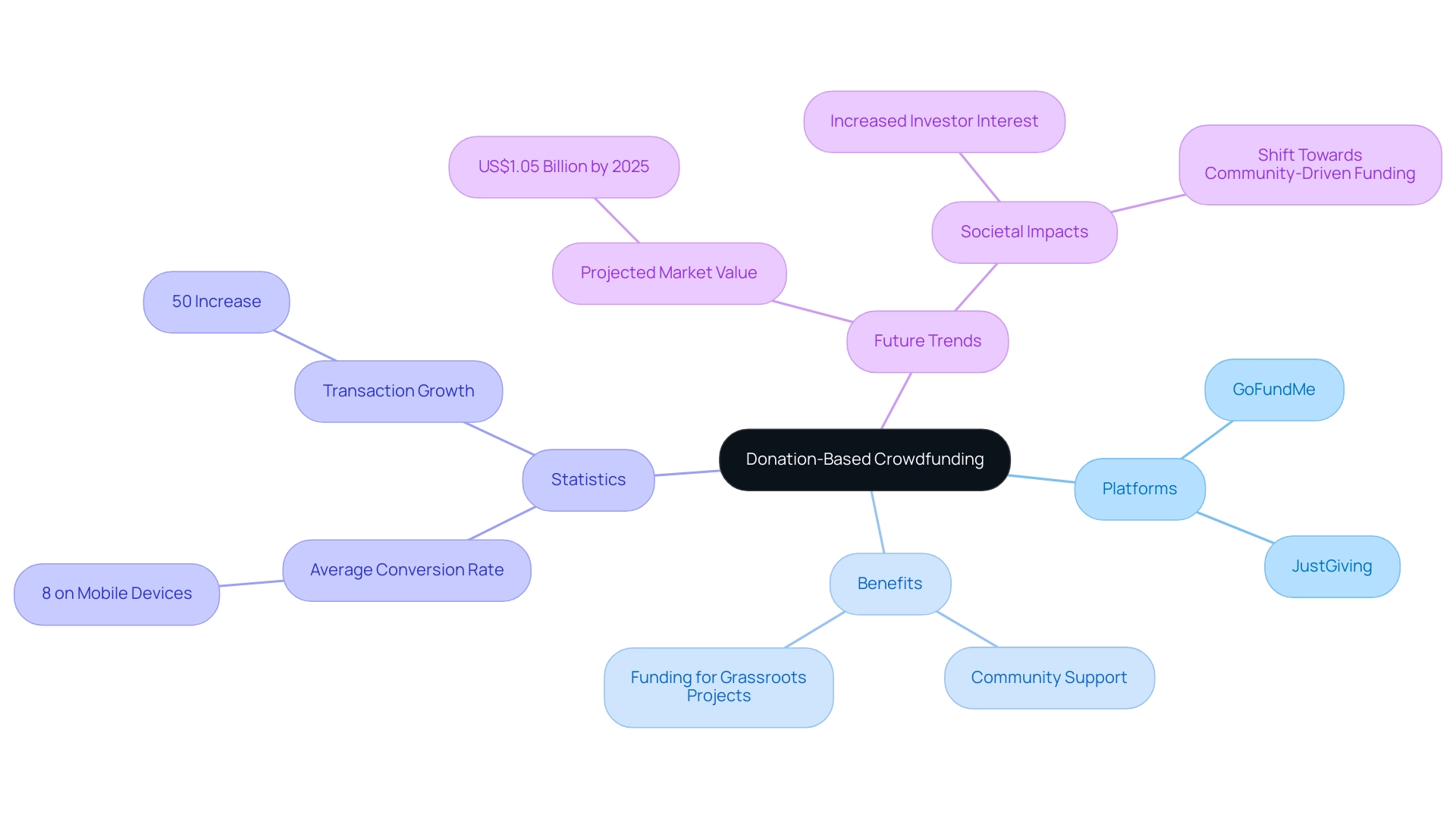
Key Features and Benefits of Donation-Based Crowdfunding Platforms
Donation-based crowdfunding platforms in 2025 are thoughtfully designed with several key features that significantly enhance the fundraising experience. These systems generally provide user-friendly interfaces that ease navigation for both creators and supporters, making the process feel more accessible and welcoming. Social sharing features are essential, enabling initiatives to connect with a wider audience through platforms such as Facebook and Twitter, which can lead to viral fundraising success and foster a sense of community.
Additionally, integrated payment processing ensures that transactions are seamless and secure, fostering trust among users and allowing them to focus on what truly matters—the causes they care about.
For project creators, the benefits are substantial. They gain access to a wider audience, enabling them to tell compelling stories that resonate deeply with potential donors. This storytelling aspect is crucial, as it helps to build emotional connections and encourages contributions that can truly make a difference.
Furthermore, successful campaigns often leverage social media to amplify their reach, tapping into networks that can lead to exponential growth in donations, creating a ripple effect of support.
Donors also enjoy distinct advantages when utilizing these services. They have a straightforward way to support causes they are passionate about, often with the added benefit of tax deductions for charitable contributions. Statistics suggest that in 2025, donation-based crowdfunding platforms are becoming increasingly popular, with sites reporting a rise in engagement and contributions, reflecting a growing community of givers.
For instance, a recent report highlighted that 25% of donations are now solicited through television, while 23% come from social media, showcasing the evolving landscape of fundraising and the various avenues available for support.
Case studies demonstrate the effectiveness of these systems. For instance, the Molly Huggins Foundation, initiated by Metropolitan Thames Valley (MTVH), seeks to allocate £75 million towards community impact projects in the upcoming ten years, showcasing the potential for lasting success through strategic funding efforts. By implementing effective strategies, creators can achieve both immediate funding goals and establish a foundation for continued growth, validating their ideas and building a supportive community around their projects.
As Akim Arhipov, founder of fff.club, emphasizes, "Financial superpowers should be accessible to everyone." This principle resonates profoundly within the fundraising environment, where services democratize financial opportunities, enabling various projects to gain visibility and support. In summary, donation-based crowdfunding platforms not only empower project creators to achieve their visions but also offer contributors meaningful ways to support causes they care about, fostering a culture of giving and community assistance.

Top 7 Donation-Based Crowdfunding Platforms to Consider
-
GoFundMe shines as a beacon of support for personal causes and emergencies, standing tall as the largest donation-based crowdfunding platform. Its user-friendly interface invites individuals to share their heartfelt stories and connect with potential donors, making it a trusted choice for urgent fundraising needs. Notably, initiatives that provide daily updates can attract 126% more funds than those that don’t, highlighting the vital role of regular interaction with backers in fostering community support.
-
JustGiving: This platform is devoted to charitable fundraising, empowering users to create initiatives for a diverse range of causes. JustGiving boasts a proven track record, with numerous inspiring fundraising stories illustrating how individuals and organizations have successfully rallied support for their missions. Yet, it’s crucial to recognize that nearly 60% of fundraising efforts on donation-based crowdfunding platforms face challenges, underscoring the hurdles users may confront.
-
Indiegogo: While primarily recognized for rewards-based crowdfunding, it also embraces donation-based crowdfunding options. This versatility enables creators to reach a wider audience, making it an appealing choice for those aiming to fund innovative projects alongside charitable endeavors. The emergence of non-fungible tokens (NFTs) as a fundraising strategy exemplifies how platforms like Indiegogo adapt to evolving trends.
-
Fundly: Fundly simplifies the fundraising journey for personal, nonprofit, or business projects. Its straightforward approach empowers users to effortlessly set up campaigns on donation-based crowdfunding platforms and share them across social media, enhancing visibility and engagement with potential donors.
-
Chuffed: Dedicated to social causes, Chuffed aims to support nonprofits and community projects in their quest to raise funds. The platform emphasizes transparency and community involvement, making donation-based crowdfunding a favored choice for those committed to creating a positive impact.
-
Crowdfunder: Tailored for community projects, Crowdfunder allows users to gather funds for local initiatives. It nurtures a sense of community engagement, encouraging supporters to contribute to causes that resonate with them personally.
-
WhyDonate: A European service, WhyDonate connects fundraisers with potential donors while fostering community engagement. Its unique approach cultivates meaningful connections, making it an effective tool for those looking to raise funds for various causes.
As we look ahead to 2025, the fundraising landscape continues to transform, with platforms like GoFundMe and JustGiving leading the way. Despite the inherent challenges, including a nearly 60% failure rate for collective funding efforts, peer-to-peer lending is anticipated to gain momentum, reflecting a shift in how individuals approach fundraising. Successful campaign creators often stress the importance of selecting the right venue, as illustrated by various case studies showcasing effective fundraising strategies on GoFundMe and similar platforms.
As Akim Arhipov, founder of fff.club, wisely noted, "financial superpowers should be accessible to everyone," reinforcing the inclusive spirit of these funding platforms.

Navigating Risks in Donation-Based Crowdfunding
Donation-based fundraising offers a wealth of opportunities for charitable causes and innovative projects, yet it comes with its own set of challenges that many can relate to. Among the most pressing concerns are:
- The risks of fraud
- The difficulty in achieving fundraising goals
- The phenomenon of donor fatigue
In 2025, statistics reveal that approximately 30% of crowdfunding initiatives fail to meet their funding targets, often due to a lack of engagement or transparency from project creators.
To alleviate these risks, it is crucial for project creators to prioritize transparency throughout their initiatives. Regular communication with donors not only builds trust but also keeps supporters informed about the project's progress and any challenges encountered. We understand that grasping the fee structures of different fundraising platforms is equally important, as these can significantly affect the net funds received if a campaign is successful.
Fraud remains a critical issue in the fundraising landscape, and it’s a concern that weighs heavily on both creators and donors. The Federal Trade Commission (FTC) has taken action against large-scale fundraising fraud, emphasizing the need for vigilance. For instance, the Civil fundraising fraud case serves as a stark reminder of potential pitfalls; despite raising over $284,000 through a Kickstarter campaign, the promised rewards were never delivered, leading to legal repercussions and restitution for affected backers. This case highlights the necessity for consumer protection in the largely unregulated crowdfunding space.
Experts in the field stress the importance of implementing robust fraud prevention measures. As Richard V. Rodriguez, an Assistant Attorney General, notes, "If they are, they should be investigated and prosecuted like any other traditional marketing or misrepresentation case." This viewpoint emphasizes the necessity for both creators and contributors to stay informed and proactive in recognizing potential red flags.
Additionally, contributor fatigue is a growing concern, particularly in an era where numerous campaigns vie for attention. Recent statistics reveal that nearly 40% of potential donors report feeling overwhelmed by the volume of requests for support, which can lead to decreased engagement over time. To combat this, project creators should focus on crafting compelling narratives and demonstrating the tangible impact of their initiatives. After all, we all appreciate stories that resonate with our values and emotions.
In the realm of collective funding, insights from Akim Arhipov, founder of fff.club, emphasize the importance of inclusivity in financial empowerment. By fostering a community of over 410 tech professionals, fff.club illustrates how accessible financial resources can enhance fundraising efforts and support diverse initiatives.
In summary, while donation-based crowdfunding platforms can be a powerful tool for social good, it is imperative for creators to navigate the associated risks carefully. By fostering transparency, maintaining open lines of communication, and implementing effective fraud prevention strategies, they can enhance their chances of success and build lasting relationships with their supporters. Together, we can create a more supportive and trustworthy fundraising environment.
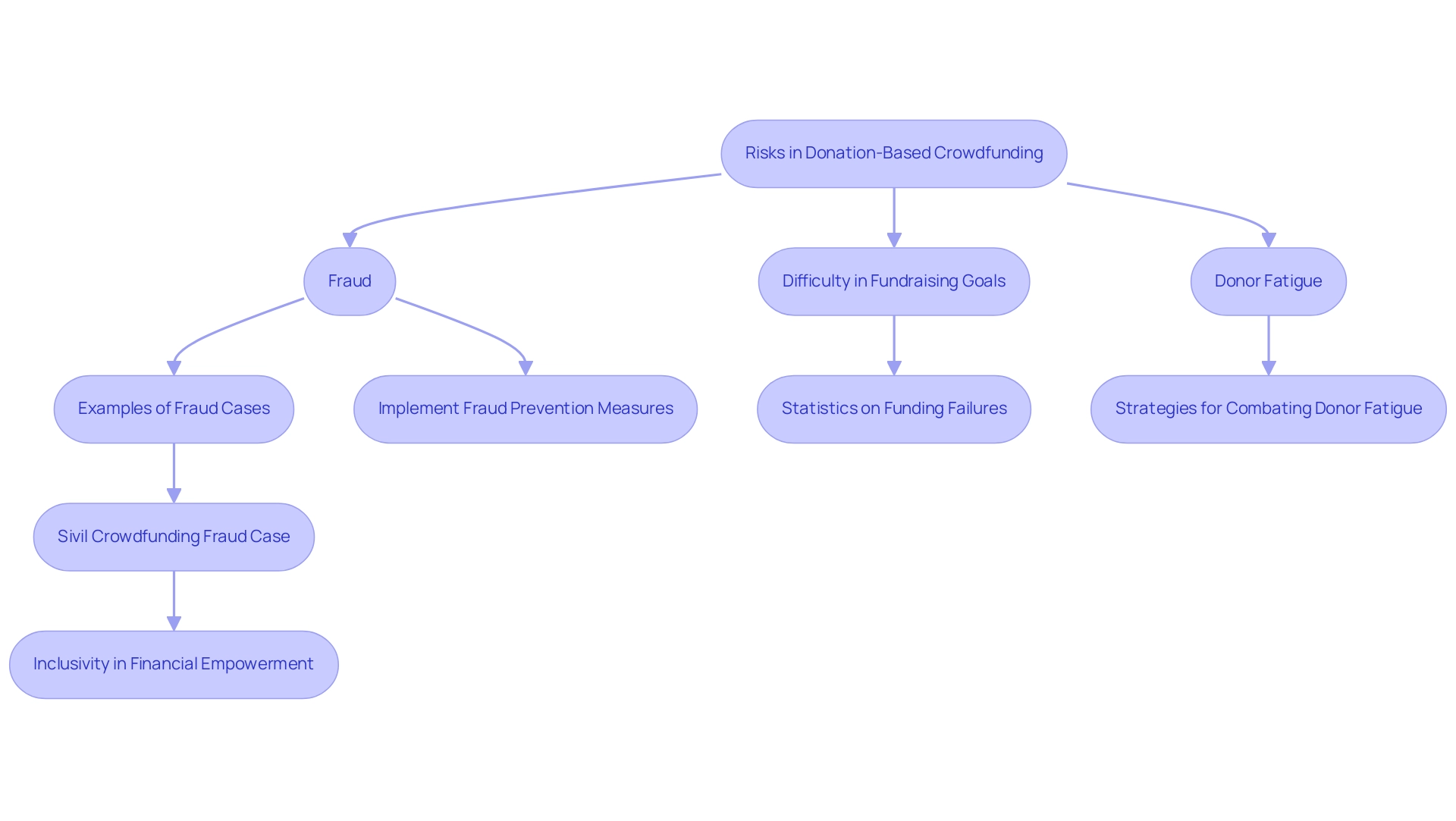
Inspiring Success Stories from Donation-Based Crowdfunding
The transformative potential of donation-based crowdfunding platforms is beautifully illustrated through numerous success stories that resonate deeply with our community. A prime example is the Haitian Solidarity Campaign, which successfully raised millions to aid earthquake victims. This initiative not only provided immediate relief but also fostered a profound sense of global solidarity, demonstrating the platform's capacity to galvanize support in times of crisis.
Similarly, Pencils of Promise has made a remarkable impact by funding thousands of classrooms worldwide through its innovative fundraising efforts. By leveraging compelling narratives and involving community members, these initiatives have shown us that effective storytelling can significantly enhance fundraising outcomes, creating connections that matter.
Statistics further emphasize this uplifting trend: in 2025, successful donation-based crowdfunding platforms are projected to raise substantial funds, reflecting a growing public interest in supporting charitable causes. Notably, mobile donations have risen by an impressive 205% recently, indicating strong engagement with digital platforms and aligning with the broader trends in collective funding for 2025.
As Lyn Wildwood, a member of the Blogging Wizard content team, insightfully notes, "Donation-based crowdfunding platforms have become a popular way to generate money for a variety of different purposes, both personal and professional." This sentiment strengthens our understanding of collective funding as a powerful means for community engagement and support.
The case study titled Crowdfunding Growth Dynamics highlights the evolving structure of collective funding, indicating a notable shift from lending to equity investment, which is growing rapidly. This evolution signals possible alterations in market dynamics over the next decade, further enhancing our discussion on the future of collective funding.
These success tales not only emphasize the efficiency of collective funding but also motivate upcoming efforts. Campaign creators often share their experiences, emphasizing the importance of community involvement and the emotional connections forged through these initiatives. As the landscape of collective funding continues to evolve, the stories of these successful initiatives serve as a testament to the power of collective action and the potential for meaningful change. Much like the collaborative environment fostered by fff.club, where members engage in co-investing and learning from one another, these narratives remind us of the strength found in community.
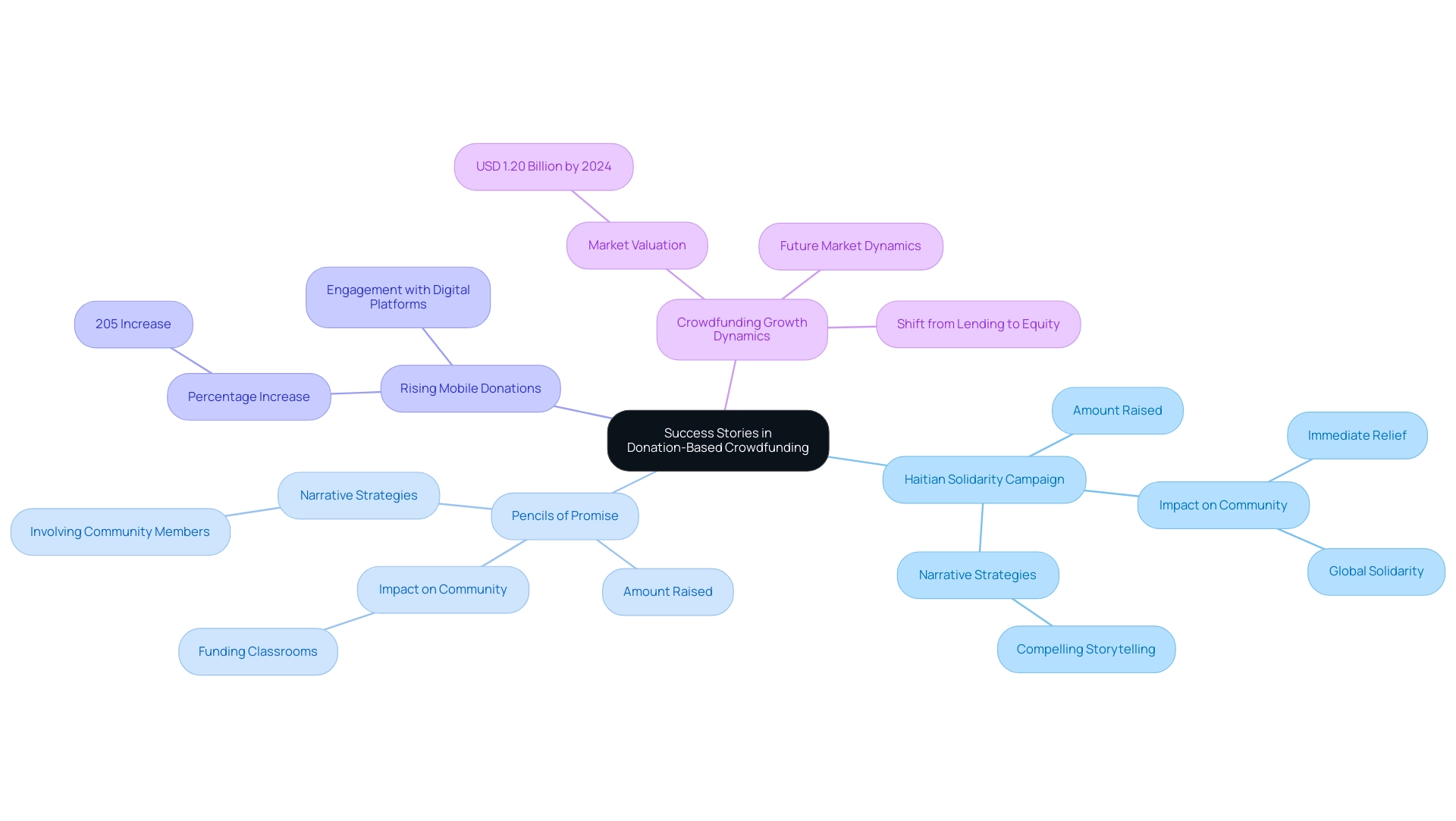
Tips for Running a Successful Donation-Based Crowdfunding Campaign
To run a successful donation-based crowdfunding campaign in 2025, we understand that you may face several challenges. Here are some essential strategies to help you navigate this journey with confidence:
-
Set Clear Goals: It's crucial to clearly define your fundraising target and articulate how the funds will be utilized. When your goals are transparent, it not only fosters trust but also encourages potential supporters to contribute, making them feel part of something meaningful.
-
Tell Your Story: Crafting a compelling narrative that resonates emotionally with your audience can be transformative. A well-told story can significantly enhance donor engagement, making them feel personally connected to your cause and inspiring them to take action.
-
Utilize Social Media: In today’s digital age, leveraging various social media platforms to promote your initiative is vital. Engaging content shared across channels can exponentially increase your reach, tapping into diverse networks and attracting a broader audience eager to support your mission.
-
Engage with Donors: Maintaining open lines of communication with your supporters throughout the initiative is essential. Regular updates on your progress and heartfelt expressions of gratitude can foster a sense of community, making your supporters feel valued and encouraging ongoing support.
-
Offer Incentives: While not always necessary, providing small rewards can enhance contributor engagement and incentivize contributions. Thoughtful incentives can create a sense of appreciation, encouraging contributors to share your campaign with their networks and amplifying your message.
-
Incorporate Expert Insights: Learning from successful campaigners who emphasize the importance of authenticity and connection can be incredibly beneficial. Their experiences can provide valuable lessons on effective strategies that resonate with donors. As Akim Arhipov, founder of fff.club, wisely stated, 'Financial superpowers should be accessible to everyone,' highlighting the importance of inclusivity in fundraising efforts.
-
Examine Successful Case Studies: Reviewing case studies of successful fundraising efforts can help identify effective strategies and common pitfalls. The increasing number of successfully funded Kickstarter projects indicates the platform's effectiveness. Understanding the demographics of backers, such as the predominance of college-educated individuals aged 25 to 34, can help you tailor your approach to better appeal to your target audience.
By employing these strategies, we believe you can improve your odds of managing a successful initiative on donation-based crowdfunding platforms, ultimately fostering significant support for your cause.
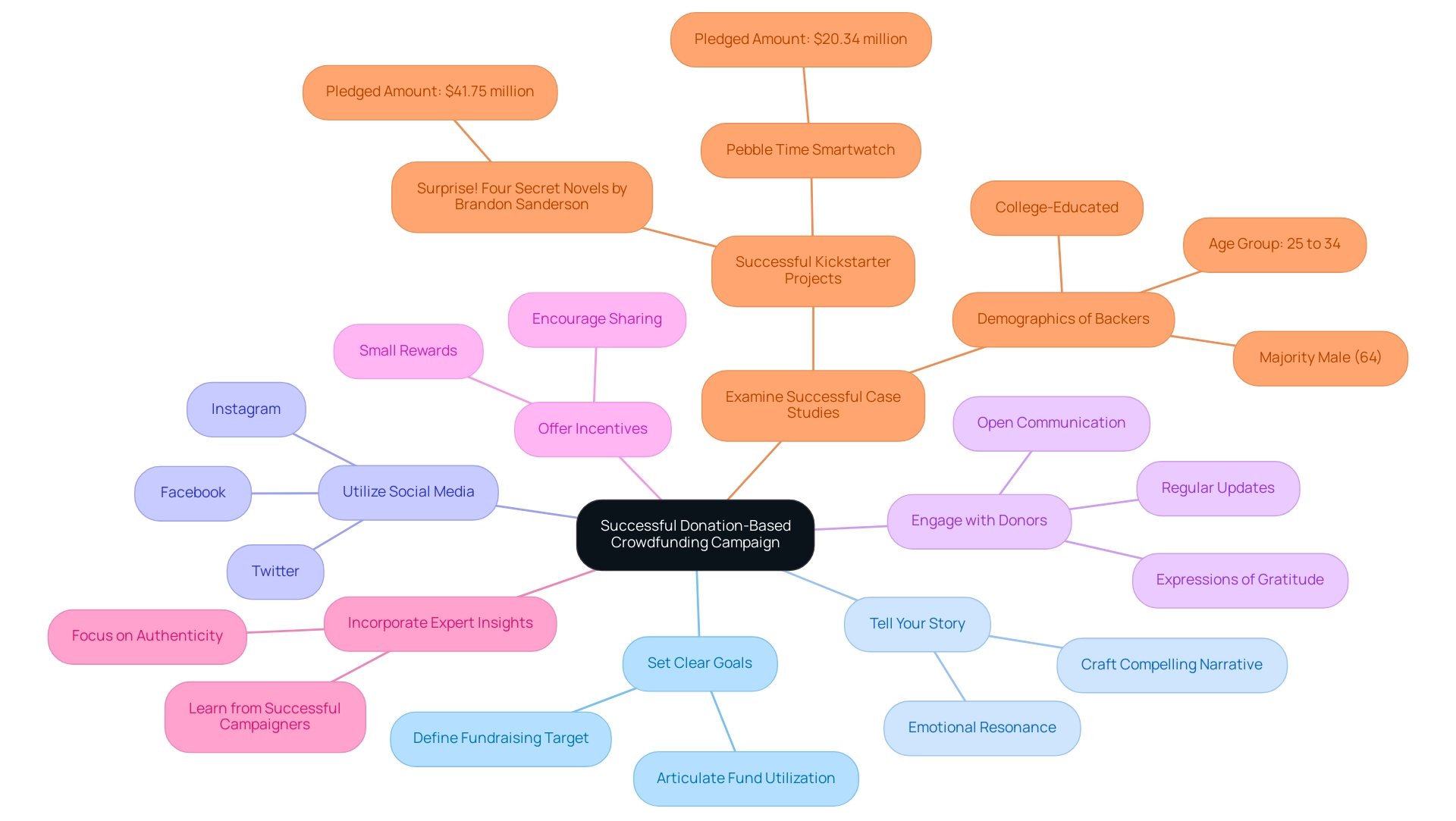
Future Trends in Donation-Based Crowdfunding
The future of donation-based crowdfunding platforms is poised for significant transformation, driven by several key trends that we should all be aware of. One of the most notable developments is the integration of blockchain technology, which promises to enhance transparency and trust in fundraising efforts. By providing a secure and immutable record of transactions, blockchain can help alleviate concerns about fund mismanagement, thereby attracting more donors to campaigns.
This shift towards transparency is particularly crucial, as many charities—over half (52%)—have identified increasing digital fundraising as a priority heading into 2025. We understand that this is a pressing concern for many in our community.
Moreover, the emergence of donation-based crowdfunding platforms tailored to specific causes is expected to gain momentum. These platforms allow project creators to connect more deeply with targeted audiences, fostering a sense of community and shared purpose. As contributor preferences change, initiatives that highlight authenticity and community involvement on donation-based crowdfunding platforms are likely to resonate more with potential backers, resulting in greater success.
Social media will continue to play a pivotal role in fundraising strategies, enabling campaigns to reach wider audiences and engage supporters in real-time. The ability to share stories and updates instantly can significantly enhance donor relationships and encourage ongoing contributions, a sentiment echoed by many of our members.
Alongside these trends, recent case studies emphasize the flexibility of funding systems in reaction to economic challenges. For instance, the National Lottery Community Fund has adjusted its funding strategies to provide longer-duration grants to grassroots projects, reflecting a broader trend of supporting initiatives that address pressing social issues exacerbated by the cost-of-living crisis. This adaptability is something we can all learn from.
As Becky Steeden, a consultant, notes, "But here’s the good news: there’s opportunity in change. Charities that are willing to adapt and test donation-based crowdfunding platforms will be better positioned to overcome these challenges. Diversification isn’t just about reducing risk; it’s about opening doors to new ways of reaching and inspiring supporters." This perspective emphasizes the importance of adaptability in the changing landscape of public funding.
Additionally, heightened consumer and government expenditure is anticipated to enhance the UK economy in the latter part of 2025, generating a positive atmosphere for funding initiatives. As we look towards 2025, it is clear that understanding these evolving trends will be essential for project creators aiming to navigate the dynamic landscape of crowdfunding successfully. By leveraging advancements in technology and prioritizing community engagement, they can position their campaigns for success in an increasingly competitive environment.
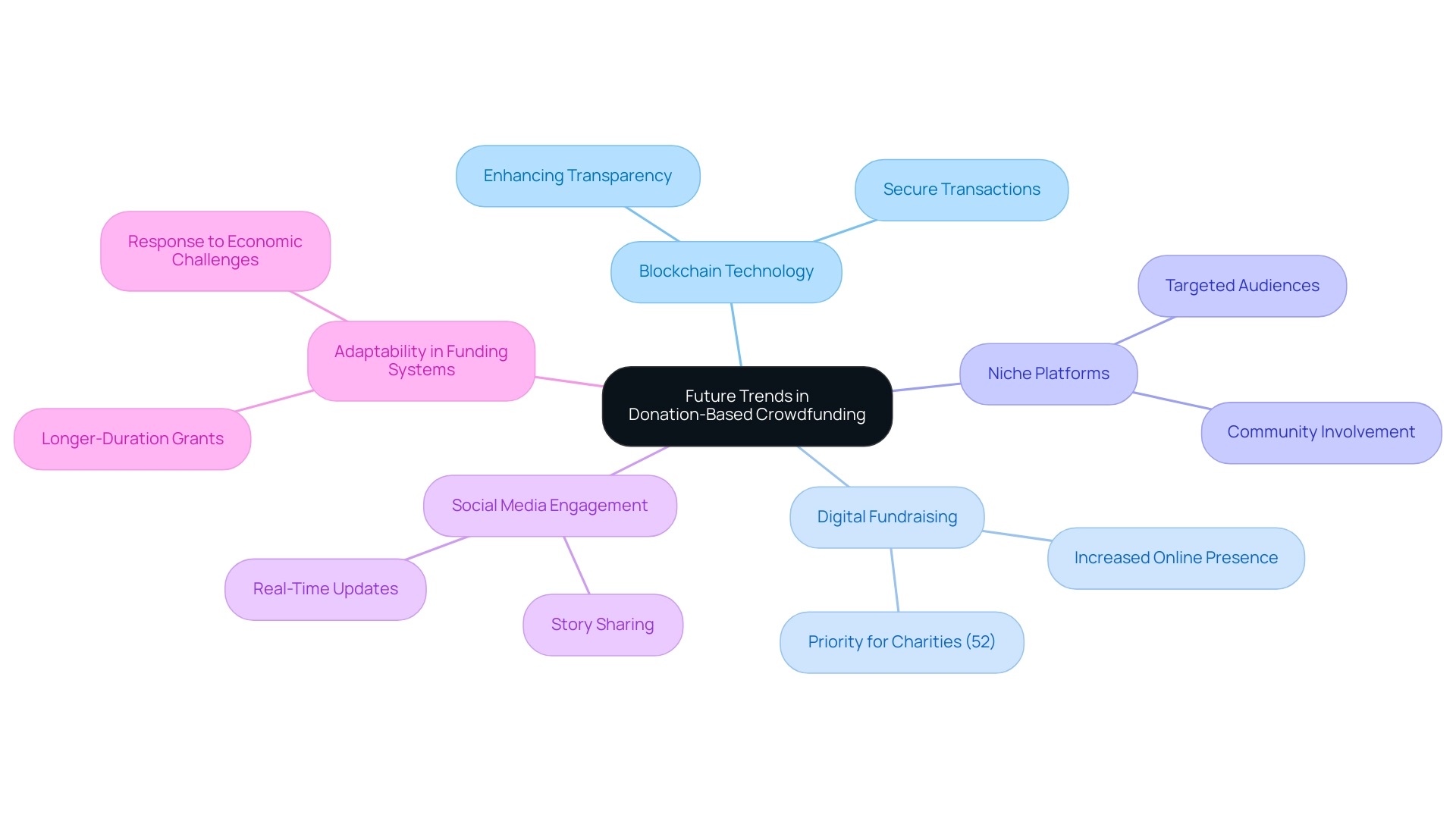
Conclusion
Donation-based crowdfunding stands at the intersection of community engagement and social impact, proving to be a vital mechanism for funding meaningful projects. By enabling individuals and organizations to connect with supporters on an emotional level, this model fosters a sense of shared purpose and collective action. The success of platforms like GoFundMe and JustGiving illustrates the potential of this approach to drive significant financial support for a diverse range of causes, from personal emergencies to large-scale community initiatives.
We understand that navigating the intricacies of donation-based crowdfunding can be daunting for those looking to make a difference. Key strategies, such as:
- Setting clear goals
- Telling compelling stories
- Leveraging social media
can enhance campaign visibility and donor engagement. Moreover, the importance of transparency and communication cannot be overstated, as they build trust and encourage ongoing support from contributors.
As many of our members have experienced, the landscape of donation-based crowdfunding continues to evolve, and embracing future trends such as blockchain integration and niche platforms will be crucial for success. These developments promise to improve transparency and foster deeper connections with targeted audiences, further enhancing the effectiveness of fundraising efforts. The stories of successful campaigns serve as a powerful reminder of the impact that collective action can achieve.
Ultimately, donation-based crowdfunding is more than just a fundraising tool; it embodies the spirit of community support and the potential for positive change. As individuals and organizations harness this innovative approach, they contribute to a growing culture of giving that transcends financial transactions, creating lasting bonds between donors and the causes they champion.
Frequently Asked Questions
What are donation-based crowdfunding platforms?
Donation-based crowdfunding platforms allow individuals to contribute small amounts of money to support specific projects or causes without expecting financial returns. They are popular among nonprofits, social enterprises, and individuals funding personal initiatives.
How do donation-based crowdfunding platforms foster emotional connections?
These platforms encourage emotional narratives in campaigns, which can drive engagement and inspire generosity, helping individuals rally support for their causes.
What are some examples of donation-based crowdfunding platforms?
GoFundMe and JustGiving are examples of platforms that enable users to create initiatives that resonate with their communities.
What benefits do nonprofits gain from donation-based crowdfunding?
It serves as a vital source of funding for grassroots projects, with online donation pages achieving an average conversion rate of 8% on mobile devices and a 50% increase in transactions.
How is the funding landscape for donation-based crowdfunding expected to change by 2025?
The transaction value is projected to reach approximately US$1.05 billion by 2025, with the United States leading at US$475 million, driven by increased investor interest and a shift towards community-driven funding models.
What factors contribute to the success of donation-based fundraising campaigns?
Successful campaigns often effectively communicate their mission and engage their audience, leading to higher success rates driven by innovative strategies and enhanced platform features.
What features do donation-based crowdfunding platforms have in 2025?
They typically include user-friendly interfaces, social sharing features, and integrated payment processing to enhance the fundraising experience and foster trust among users.
How do project creators benefit from these crowdfunding platforms?
They gain access to a wider audience, allowing them to tell compelling stories that resonate with potential donors, which helps build emotional connections and encourages contributions.
What advantages do donors experience when using these platforms?
Donors can easily support causes they are passionate about, often receiving tax deductions for charitable contributions, and they benefit from engaging with a growing community of givers.
Can you provide an example of a successful initiative using donation-based crowdfunding?
The Molly Huggins Foundation, initiated by Metropolitan Thames Valley, aims to allocate £75 million towards community impact projects over the next ten years, demonstrating the potential for lasting success through strategic funding efforts.



